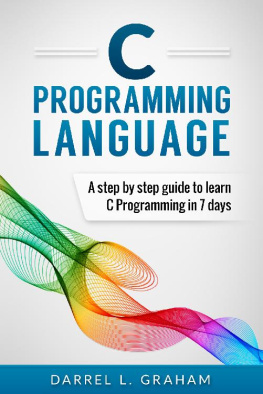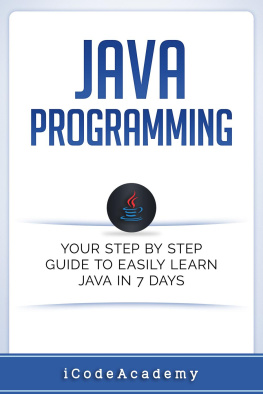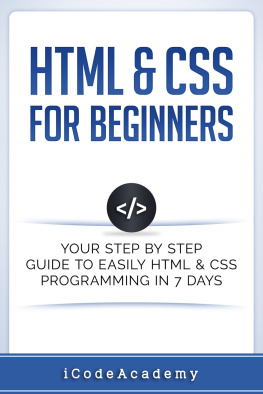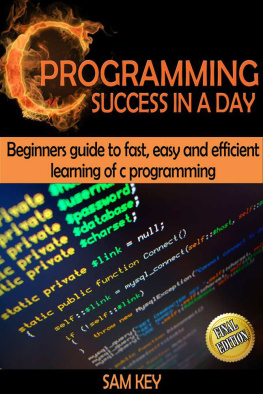C PROGRAMMING LANGUAGE
A Step By Step Guide To Learn C Programming In 7 Days
Darrel L. Graham
Amazon Kindle Edition
C PROGRAMMING LANGUAGE
Copyright 2016 by Darrel L. Graham
The contents of this book may not be reproduced, duplicated or transmitted without direct written permission from the author.
Under no circumstances will any legal responsibility or blame be held against the publisher for any reparation, damages, or monetary loss due to the information herein, either directly or indirectly.
Legal Notice:
This book is copyright protected. This is only for personal use. You cannot amend, distribute, sell, use, quote or paraphrase any part or the content within this book without the consent of the author.
Disclaimer Notice:
Please note the information contained within this document is for educational and entertainment purposes only. Every attempt has been made to provide accurate, up to date and reliable complete information. No warranties of any kind are expressed or implied. Readers acknowledge that the author is not engaging in the rendering of legal, financial, medical or professional advice. The content of this book has been derived from various sources. Please consult a licensed professional before attempting any techniques outlined in this book.
By reading this document, the reader agrees that under no circumstances are is the author responsible for any losses, direct or indirect, which are incurred as a result of the use of information contained within this document, including, but not limited to, errors, omissions, or inaccuracies.
Table of Contents
Introduction
C Programming Language introduces you to the most commonly used programming language, one that has been the basis for many other versions over the years. It is a great book, not just for beginning programmers, but also for computer users who would want to have an idea what is happening behind the scenes as they work with various computer programs.
In this book, you are going to learn what the C programming language entails, how to write conditions, expressions, statements and even commands, for the language to perform its functions efficiently. You will learn too how to organize relevant expressions so that after compilation and execution, the computer returns useful results and not error messages. Additionally, this book details the data types that you need for the C language and how to present it as well.
Simply put, this is a book for programmers, learners taking other computer courses, and other computer users who would like to be versed with the workings of the most popular computer language, C.
Chapter 1:
What Is The C Language?
C Programming is one of the most useful and easy to use computer programming languages. The person who came up with this C Programming went by the name of Dennis M. Ritchie, and he worked at Bell Telephone Laboratories. At the time, precisely in 1972, C Programming was meant to help in improving the now widely used UNIX operating system, whose development had begun in 1969. And did it? Yes, it did. Its kernel code now began to use fewer lines than it did before when it used the assembly programming language, which is commonly abbreviated as asm .
That does not mean that the C language is restricted to only a few lines. It can actually take as few as three lines or as many as millions of them. At the same time, it is written in a single text file or a number of them, the text files bearing the extension, c, as in, hello.c.
As for its introduction to the market, the C programming language was not available to the public until 1978 when Ritchie joined hands with Brian Kernighan to produce the first set for commercial use. That is where the now common term, K & R standard, was derived from Kernighan and Ritchie. It is important to point out that the C programming language was officially formalized by the American National Standard Institute , abbreviated as ANSI, in 1988.
Other Early Projects Improved By C
Oracle
UNIX was not the only project to be made more efficient by the C Language. The Oracle database also benefitted when, in 1983, its initial code that had been written in asm was re-written in the C language. The development of the Oracle database had begun in 1977.
Windows 1.0
Windows 1.0, which was released in 1985, is said to be partially written in C and partially in assembly or asm . The source code is, however, not available to the public.
The Linus kernel
The Linux kernel, which was released in 1992 as a composite part of the GNU operating system, and whose development began in 1991, also uses the C Language. Although some of GNUs components use Lisp programming languages, it still has others that use the C programming language. Incidentally, any idea what GNU represents? Well, apparently, IT is not all serious stuff without fun GNU is Wait for it GNUs Not Unix - some artistic thinking there.
Anyway, for practical purposes, C language is more procedural than anything else and can be used for different operating systems. It is actually the most used so far worldwide, though it faces great competition from Java, another popular programming language.
Who uses the C Programming Language today?
The C Programming language is mostly used by software developers or programmers and particularly those using the operating system, UNIX, C compiler, and virtually every application program of UNIX. Suffice it to say, the C programming language is today the most used professional language in the world of computers.
Modern systems based on C Programming
The C Programming language, as has been stated before is still widely in use. It cannot pass as a programming language of old just because it helped to upgrade ancient programs. As this book will show, despite software experts having developed other programming languages, C is still in great demand.
Here are some modern systems still based on C:
1. Microsoft Windows
The Microsoft Windows operating systems dominate the computer market, taking around 90% market share. And their kernel is written in the C programming language for most part, fewer parts being written in asm .
2. Linux
Linux is another system written in the C programming language. This is significant because, in addition to Linux being used in personal computers, it is also the system used by the worlds topmost supercomputers; actually the top 500 of them. Just to bring it home better, here are the 10 leading supercomputers in the world, part of the list of computers using the C language:
(i) Tianhe-2
Tianhe-2 is the name of the worlds most powerful supercomputer. It is owned by the National Supercomputer Center , which is in Guangzho, China. This great computer was built in China by the National University of Defense Technology , abbreviated as NUDT.
(ii) Titan
This one joined the top league after being upgraded in 2012. Its location is Oak Ridge National Laboratory in the US , and its user is the United States Department of Energy.
(iii) Sequoia
This is another US supercomputer, and it is located in Lawrence Livermore National Laboratory in the state of California. It has been used largely in matters of climate, energy, as well as astronomy.
(iv) K Computer
The K Computer is a product of Fujitsu, who built it at the Advanced Institute for Computational Science (AICS). This institute is within RIKEN, Japans biggest research institution, situated in the city of Kobe.
(v) Mira
This is another of USs supercomputers. It is located within the Argonne National Laboratory , which is at the outskirts of Chicago, and is largely used the US Department of Energy.






